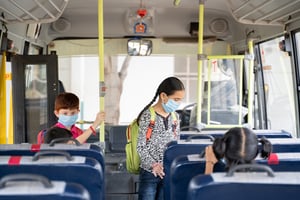Student Transporters Discuss Meeting Challenges
published on December 29, 2020 by Sonia Mastros
Student Transportation, student bus transportation, student transporters
 Contrary to the hopes of many, there's no sign that the COVID-19 coronavirus is going away any time soon. In fact, new infections across America are at an all-time high. This means that it's vital for school districts and student transportation directors to do everything they can to protect students and staff from infection while riding on school buses.
Contrary to the hopes of many, there's no sign that the COVID-19 coronavirus is going away any time soon. In fact, new infections across America are at an all-time high. This means that it's vital for school districts and student transportation directors to do everything they can to protect students and staff from infection while riding on school buses.
Fortunately, with some districts now having been back in operation for two months or more, we're seeing some common strategies involved. Based on a recent series of STN interviews, we've noticed some responses and suggestions that appear repeatedly. These are some of the most common and apparently effective steps that any district could take.
Proven Strategies Student Transportation Directors Are Using To Protect Bus Riders From COVID-19
1. Have parents drive as many students as possible.
Schools are legally obligated to provide transportation to every student in need - but they can still ask parents to help! Any parent who can bring their student in their vehicle should be doing so. Overall, bus ridership needs to come way down to keep students safe, and this is a big way that parents can help out.
Of course, having mixed in-person/remote-learning classes also help keep bus ridership down, but this is not always an option for every district.
2. Limit students to one per seat.
"Perfect" social distancing is not really possible on a school bus, but restricting the number of riders per seat can help. Ideally, there should only be one student per seat, so that no one is sharing air too much air - or physical contact - with anyone else.
Exceptions can be made for siblings or students who otherwise cohabitate. Separating them would accomplish nothing, so it's fine for them to sit together.
3. Require masks.
We realize that mask requirements may cause pushback in some areas, but schools need to remain steadfast. Facial masks are still one of the single most effective tools in preventing the spread of the coronavirus, and other airborne diseases. Students simply should not ever be allowed onto buses without a mask, not without genuinely compelling medical reasons.
At least masks are now widely available again, so it's a good idea to keep a box of masks by the bus entrance for students who don't have one.
4. Disinfect everything.
Even though it's time-consuming, buses need to be disinfected after every run. Any surface a student might have touched should be wiped down with alcohol disinfectant, at the very least. Other options also exist, such as automatic misters and foggers, which can make this process easier.
There are no easy or simple solutions to protecting student transportation systems from the coronavirus. What is your district doing to keep your buses safe? Please share your tips in the comments!



